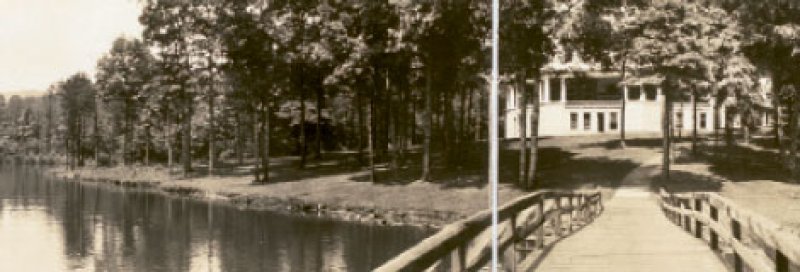The Great Lakes
The Great Lakes: The two heydays and incarnations of Lake Toxaway were separated by a very dry period
With 14 miles of private shoreline and a scenic mountain backdrop, Lake Toxaway is the quintessential picture of travel and leisure in Western North Carolina. But more than 100 years ago, the area was rugged, inaccessible, and devoid of any such body of water. When the Toxaway River was dammed, the resulting lake and luxury resort lured the rich and famous. But what’s most impressive is Lake Toxaway’s rebirth after the dam broke.
In 1902, Pittsburgh entrepreneur E.H. Jennings created a 640-acre body of water, which he named Lake Toxaway (the Cherokee word for “red bird”) and built the Toxaway Inn. The luxury resort opened the following year, and for nearly two decades hosted the country’s elite, including Henry Ford, Thomas Edison, Harvey Firestone, and John D. Rockefeller. But the party ended in the summer of 1917 when the earthen dam broke and the lake emptied out overnight. The once-glamorous mountain community faded away and the inn was torn down in 1948.
Twelve years later, South Carolina developer Reg Heinitsh saw the area’s potential. He purchased nearly 9,000 acres and set out to rebuild the lake, which had become overgrown with trees.
He enlisted the services of his son, Reg Heinitsh Jr., who now owns and operates the resort with his own son. Heinitsh Jr. explains that they first built a new dam and 48-inch culverts at the base of the lake, then constructed a 130-foot spillway to control the release of water. “There was basically a forest floating under the lake,” Heinitsh Jr. says. “I was on a barge every summer for three years pulling logs out of the lake bed.”
As the lake came to fruition, Heinitsh Sr. built luxury homes, a mountaintop golf course, and clubhouse on the surrounding property. The rebirth of Lake Toxaway soon garnered attention. The New York Times ran an article in October 1961 about “the return of the wild and beautiful Lake Toxaway,” claiming that, “Like Rip Van Winkle, the region is emerging from a prolonged period of dormancy.”
Today, Lake Toxaway is the largest privately held lake in North Carolina, and remains a popular resort destination. Measures such as low-density developments and land conservation easements have been taken to preserve the area’s natural beauty. And as long as the dam holds strong, it will remain that way for many years to come.
